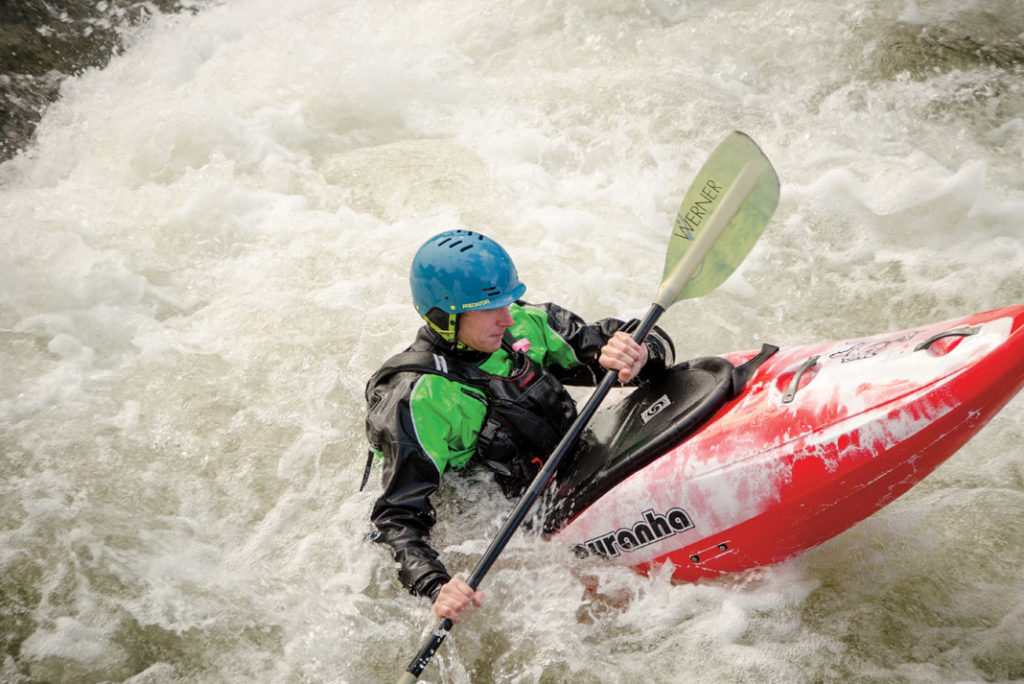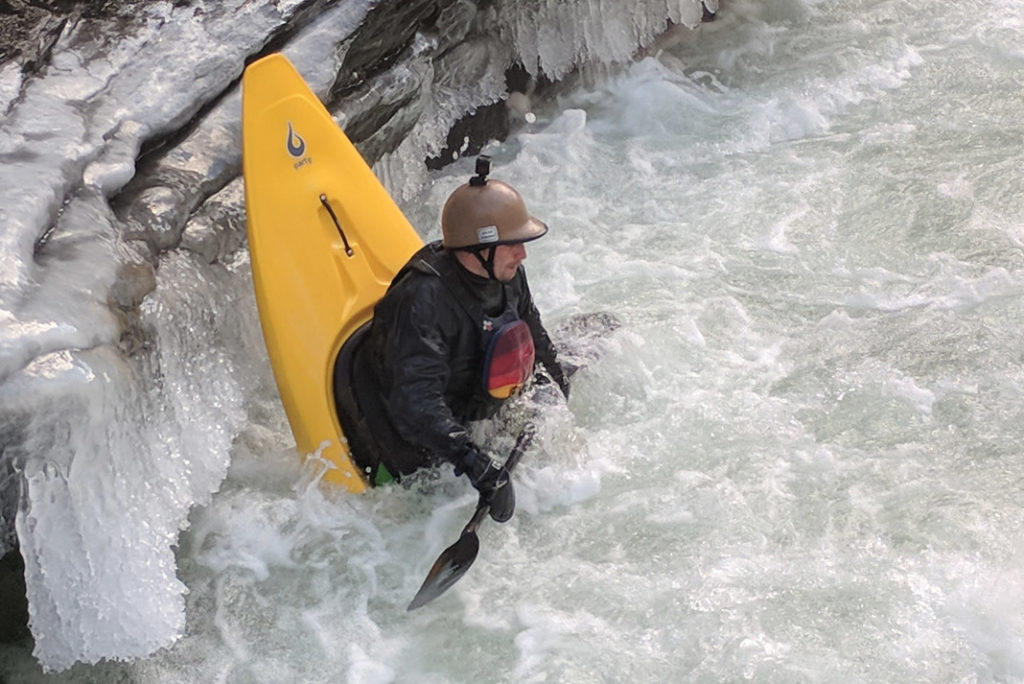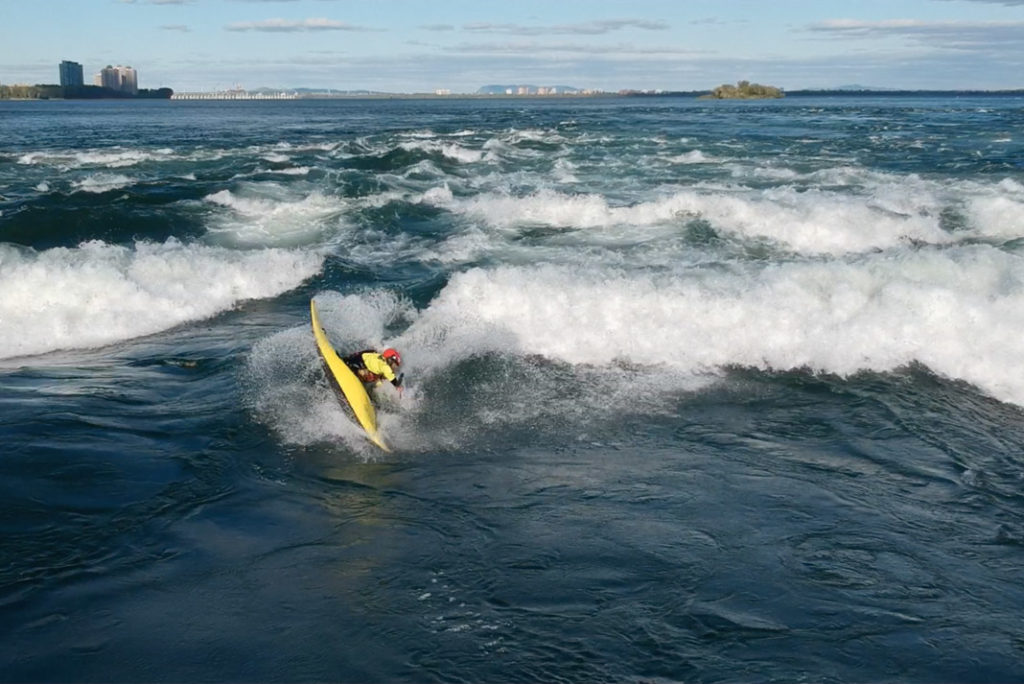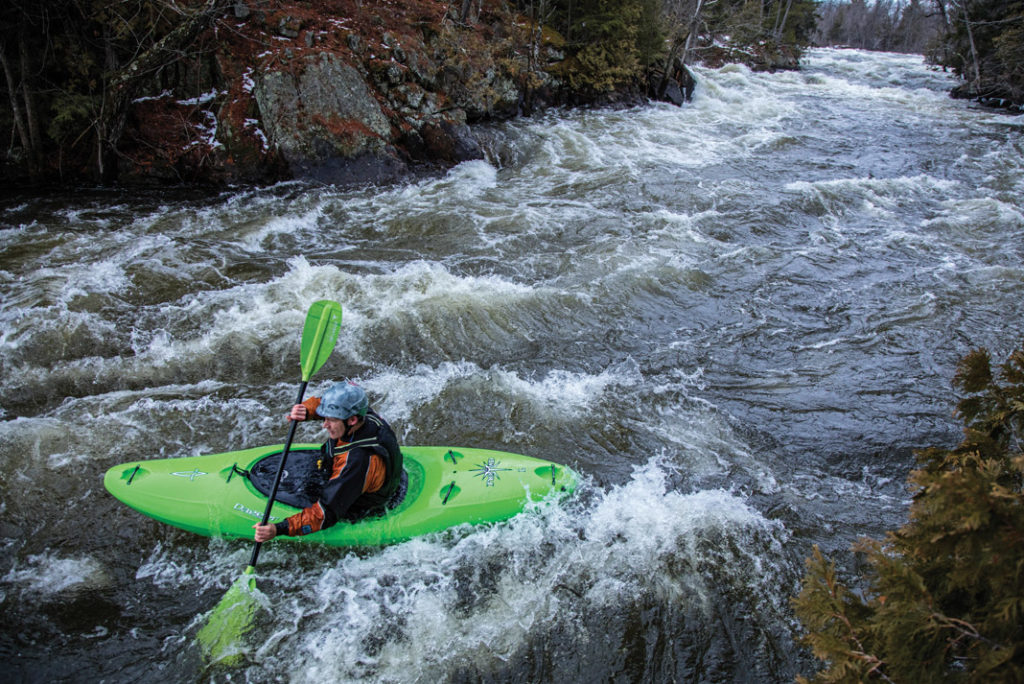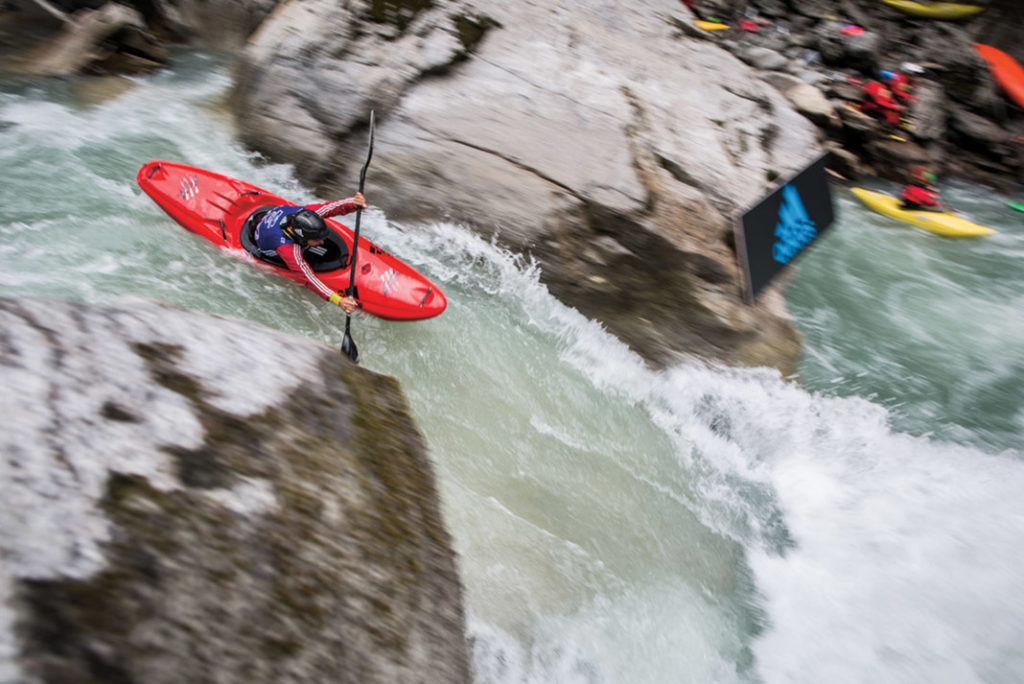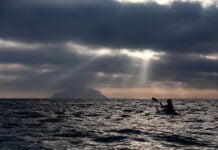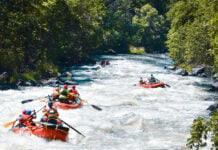If you’ve ever run shuttle with someone over 40 you’ve heard this before, but listen up, because it’s important. Modern kayaking began on the day in 1973 when the first plastic boat hit the market. Until then, you made your own boat out of fibreglass, usually on a borrowed mold, always in an unventilated basement.
Your boat was 13 feet, two inches long because the slalom rulebook said it should be, and the first thing you learned was to miss all the rocks because if you hit one you’d be back in the basement, huffing resin and sanding patches.
Then the Hollowform River Chaser came out, and suddenly it was okay to run into things.
Slowly at first, boaters discovered it could be fun to bounce off obstacles. The boof became a core river running technique. Splats became a thing, and shallow wave holes went from places to be avoided to the most popular play spots on the river.
A whole new style of kayaking was taking hold, and it set off an explosion of innovation in the 1990s
Rodeo was king, with athlete designers like Eric Jackson and Corran Addison driving the progression both in the shaping room and on the newly ascendant freestyle circuit.
At the start of this creative spasm, the Perception Pirouette, heralded as “the ultimate playboat” in the company’s 1993 catalog, was 11 feet, two inches long. Less than a decade later, somewhere around the time Popular Science declared the Dagger UFO the “most agile kayak yet,” which was never released but became the Dagger G-Force 5.9. In fairness, no kayaker today would call the Pirouette a playboat, and the unremarkable UFO lasted about as long as the bunions it ground into the tortured toe knuckles of its owners. But the trend towards ever-smaller boats had finally approached its logical limit.
The only place left to go was back to the future.
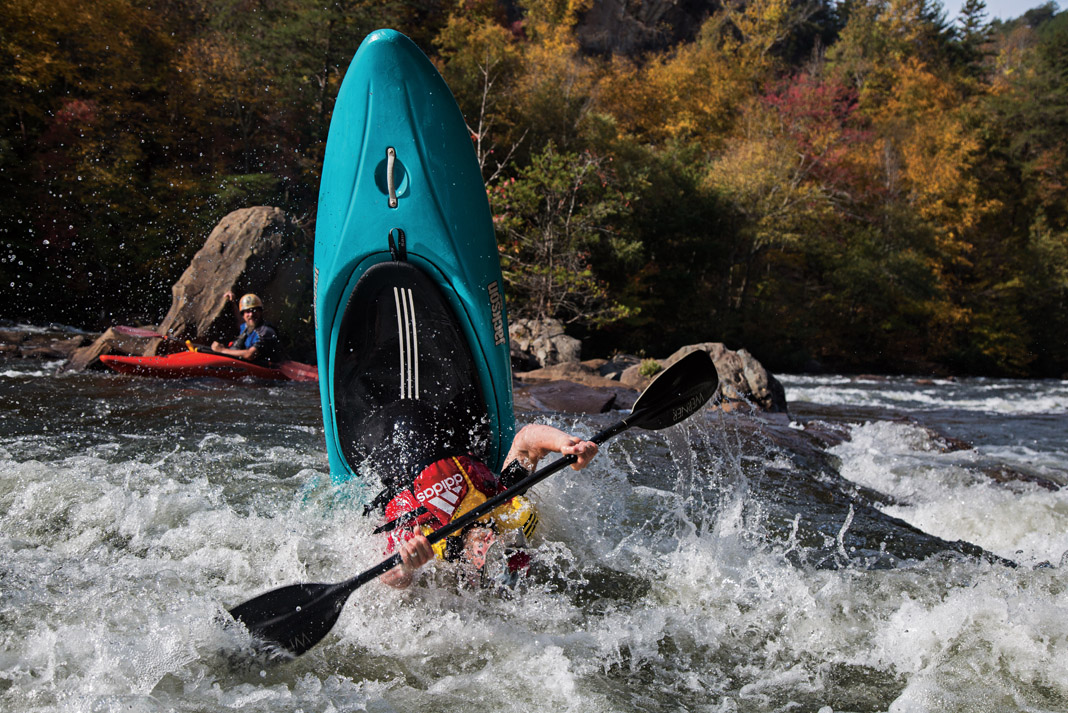
Full circle
The design explosion of the 1990s gave us a number of iconic boats like the Prijon Rocket and the quintessential slicey playboat, the WaveSport X. But no boat has had a more lasting impact than the Dagger RPM, a squash-tailed eight-foot, 11-inch revelation debuting in 1995.
Eric Jackson won the 1993 World Freestyle Kayak Championship in a ‘glass prototype, but the production version took two more years to reach the market because Dagger boss Joe Pulliam thought it was too radical for mainstream success. The market proved him wrong.
The RPM would become the best-selling whitewater kayak ever, and 23 years later is enjoying a resurgence
“People still gravitate towards it,” says Dagger designer Mark ‘Snowy’ Robertson. “It’s kind of a soul-boating thing. The grace of the way the boat flows downriver is what attracts people.”
The same could be said of the new generation of playful river runners following in its footsteps, including Dagger’s own Axiom, Jackson Kayak’s Antix, Pyranha’s Ripper and Soul Waterman’s Funky Monkey.
Liquidlogic joined the party in 2015 with two variations on the theme, the eight-foot, 11-inch Braaap, and the aptly named nine-foot Mullet. The moniker perfectly describes the boat’s design parameters—business up front, party in the back, with a not-so-subtle nod to its mid-90s inspiration. True to their old-school roots, the Braaap and Mullet both have displacement hulls, with tapered low-volume sterns making every eddyline a playground.
The resemblance to the RPM and other old-school classics like the New Wave Sleek and Perception Whip-It is no coincidence, says Liquidlogic head of design Shane Benedict. The lineage is direct, and like many trends in whitewater paddling its roots drink deeply from the Green River.
The iconic North Carolina Run is home to the Green Race and some of the most influential designers in the sport…
…including Dagger’s Robertson, Pyranha’s Robert Peerson and Benedict, who even as a self-professed “old guy” still logs upwards of 70 Green laps a year.
There may be no better routine in boating than daily Green laps, but it’s still a routine. So a few years ago Green regulars began pulling all sorts of old boats out of barns and backyard sheds to keep it fresh.
“There are a lot of old boats floating around, and somebody would get ahold of one of them and just have the best day out on the river,” Peerson says.
In their heyday, few would have dreamed of piloting those boats down a class V creek, but for today’s skilled boaters they’re the perfect craft to wring just a little more fun out of a familiar run. The manufacturers took note, and soon the re-evolution of the downriver playboat is in full swing.
“People are rediscovering the things we were doing a long time ago, figuring out stern squirting and cartwheeling and the flatwater stuff,” Benedict says. “The old boat revival was hot and heavy on the Green so it was pretty easy for us to see it and say, ‘Let’s see if we can make a new squirty boat that can get them out of those $300 used boats.’”
That’s exactly what happened.
The slicey river runners have taken the kayaking world by storm
They’re especially suited to class III-IV standards—backyard runs boaters know well, with both challenging rapids and plenty of opportunities for play. More advanced paddlers are using them to spice up bread-and-butter class V runs.
Nearly every company now has one on offer, and judging by the eddy chatter and general excitement it’s hard to go wrong with any of them.
Dagger’s eight-foot, six-inch Axiom and Jackson’s seven-foot, nine-inch Antix are among the shorter boats in the class, with planing hulls that surf well and snap in and out of eddys. They’re on the playful end of the spectrum, designed to extract the maximum amount of fun from every seam, pillow and wave on the river.
Soul Waterman’s Funky Monkey is a rangy nine feet, nine inches, built for speed with a flat-bottomed hull and a little less bow volume than other boats in the class. Pyranha’s nine-foot Ripper takes the pronounced bow rocker and fast-is-fun approach of its acclaimed 9R creeker and mates it to a playful stern. The Mullet is the harder-partying of Liquidlogic’s two slice-tails, while the Braaap is more of a river-runner, with a narrower hull profile (24 inches wide compared to the Mullet’s 26 inches) and more balanced volume distribution. Both draw on slalom influences and in the right hands will make race-inspired eddy carves and stern pivots into things of beauty.
The Party Braaap straddles the gnar-play divide thanks to a slicier stern than the original. Liquidlogic spins it in the same mold as the standard Braaap, then uses a template to squash the stern into a more playful profile while the plastic is still warm. The result is more predictable than rolling over it with a truck, and just as strong as a fully molded boat.
But wait, there’s more
The slicey re-evolution started in the tail, but it’s not going to end back there. New playboats coming to market this spring take the logical next step, extending low-volume slice to the bow with shapes reminiscent of such revolutionary designs as the WaveSport XXX.
Jackson’s squirty double-ender, the MixMaster, began shipping in February. “The type of paddling you do in it is different than a modern freestyle kayak,” says JK president Eric Jackson. The combination of length, low volume and narrow ends engaging the water—Jackson calls them wings—is the key to a toy box most kids today didn’t even know existed. Factor in the freestyle progression of the last decade and a half, and it will be interesting to see what the new generation of boaters does with these slicey playboats, Jackson says.
Even the old dog has learned some new tricks
“I have already been able to do some new moves in it nobody was doing in the 1990s and 2000s in that style boat, because I’m applying what I have learned in my modern freestyle kayaks,” Jackson says.
Liquidlogic also has a slicey playboat on tap. The company has been testing prototypes since Gauley Fest last September, with the much-anticipated design set to ship in April. At press time Benedict told us the shape was dialled in, with a seven-foot, eight-inch planing hull and 55 gallons of volume centred around the cockpit, though the name was still a work in progress. Homeslice has been bandied about, as has Obsession—a nod to Liquidlogic’s influential original playboat, the Session.
“It’s slicey on both ends, so it’s very much like the older playboats,” Benedict says. “There’s definitely some history of the Session in this boat, as well as one of my earliest designs, the Mr. Clean from back in the Perception days.”
Ironically, the segment pushing kayak design to the bleeding edge in the 1990s and early 2000s has seen the least innovation in the last few years.
One thing is certain. The athletic progression has continued across the board.
“There’s been little design progression from about 2005 to 2015, but the techniques, the skills, the tricks, the creeks, the drops—what people were doing with these boats—increased exponentially,” says Corran Addison, who was the poster boy of new school innovation until the mid-2000s, when he found a new focus for his manic energy in paddle surfing.
Now back in the kayak game after an eight-year hiatus, (see the Soul Waterman Main Squeeze review) Addison sees parallels with surfing’s so-called shortboard revolution. In the 1970s, surfing progressed rapidly from longboards, which are nine feet or longer, to shortboards which are often less than six feet. The new shapes were harder to ride and required faster, more critical waves. As a result, surfers either got really good or they stopped surfing altogether. Then in the 1990s longboards made a comeback—with a difference.
“The longboards from the ‘90s were not the same as in the ‘70s because the shapers incorporated what they learned with shortboards,” Addison says. A similar dynamic is playing out now in kayak design.
Designers simply have more experience and more data to work with
They have a better understanding of how inputs like rocker and hull profile interact, and this means better boats for everyone.
As an example, Addison offers his new Soul Waterman 303. “It’s a 10-foot high-performance playboat inspired by a 27-year-old Riot Scorpion,” he says. “You hear this and you say what? But I’d just spent a week paddling through the Namib Desert on the Orange River and left my Main Squeeze, a six-foot, 10-inch all-around freestyle boat, on the oar raft. I paddled all but one day in the Scorpion, because it’s fast and I was squirting and splatting every rock in sight and surfing every wave.”
Addison says the only thing the Scorpion couldn’t do is spin and blunt, so when he got home to Montreal, Quebec, he grafted a high-performance hull and modern outfitting onto a deck inspired by designs like the Scorpion and its old-school stable mate, the Sabre. The result is a 10-foot playboat which spins and blunts, at least with Addison at the controls.
Is this the future?
It remains to be seen, but as Benedict says, “It’s nice to see what Corran is up to.”
The need for speed
While downriver boats have been all about slicey sterns of late, the creek boat evolution has been all about speed, with designs like Pyranha’s 9R and Waka Kayak’s Tuna ushering in a new generation of fast, highly rockered, planing-hull creekboats.
“Speed and bow design are two things critical in creekboat design in the past five years. Add user-friendliness and you have a winner in the market,” Jackson says, citing as an example his company’s Nirvana, which debuted in 2017 featuring pronounced bow rocker and a speedy nine-foot planing hull.
More new creekers are recently arrived or in shops this season
Dagger’s new Phantom was designed with extensive input from the company’s pro team. It features a highly rockered bow combined with low stern rocker and a defined parting line—a combination Dagger’s Chris Gragtman’s says will “go over everything and anything you put in its way,” and accelerate out of drops “like a Jet Ski.”
Liquidlogic’s new Delta V 88 creeker is the brainchild of Pat Keller. The eight-foot, six-inch design features a soft-edged displacement hull and rocker profile devotees of the Braaap will find reassuringly familiar. The boat also features “Turbo Booster” pockets on the stern, which Keller says help the boat accelerate away when loaded after a drop. The creeker’s name is a play on the quick acceleration: Delta V is science-talk for change in velocity.
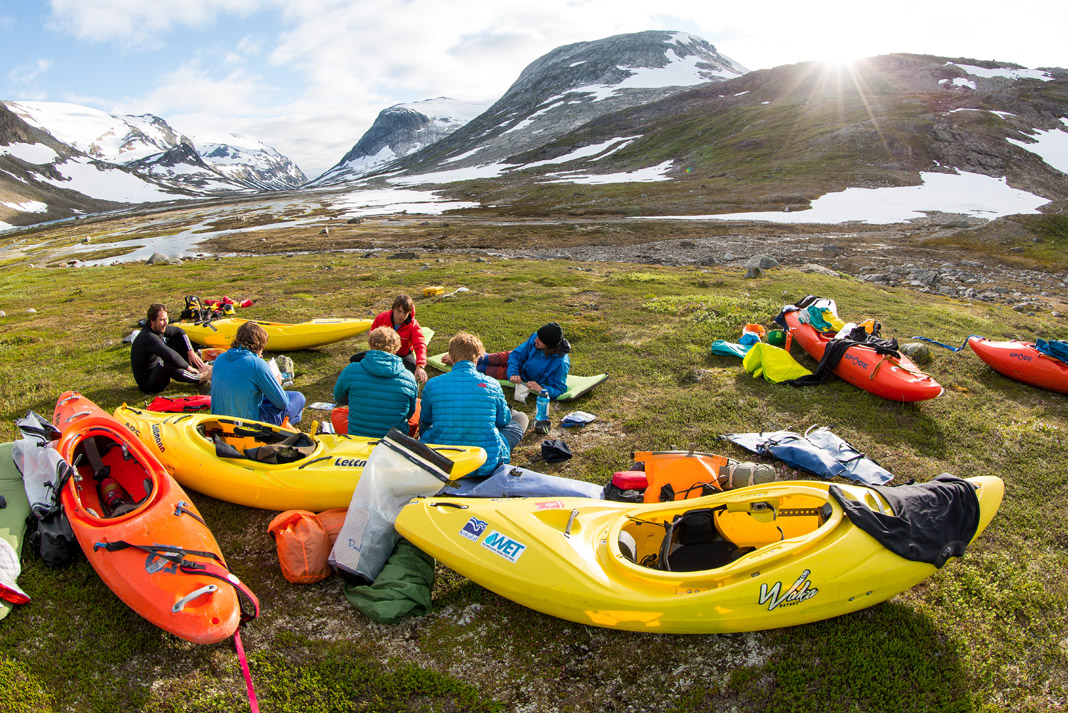
Pyranha’s latest creekboat also has a name needing explaining
The Machno has nothing to do with spicy corn chips or Latin masculinity—it’s a shoutout to the Afon Machno, a tributary of the Fairy Glenn run where the Pyrahna U.K. crew put the prototypes through their paces. The Machno’s lines are reminiscent of the company’s trend-setting 9R, with a semi-planing hull and plenty of rocker in bow and stern.
Waka Kayaks, the small New Zealand-based company making an outsized contribution to the latest generation of creekboats, also has a new model, the OG. “It has loads of rocker and rides over everything,” designer Kenny Mutton says of the eight-foot, seven-inch planing-hull creeker. “We made it for full-on creeking—basically something you could just fall down the river in—but we were surprised how nimble it is in and out of eddys. It’s really fun on class III too.”
The future
Kayaking has a long history of niche designs, from squirtboats and longboats to kid crafts. Paddlers like to pass themselves off as free spirits, but when it comes to running rivers they can be an obsessive lot. Take Dagger’s original Green Boat, which enlisted an entire company in a mad conspiracy to win the Green Race. It worked, and then Dagger found a market for it, prompting other companies to debut their own 12-footers—Jackson with the Karma UL and Liquidlogic with the Stinger.
Though built purely for speed, boaters soon found these longboats make great self-support kayaks as well. Expedition paddler Ben Stookesberry used a Karma UL on long expeditions in Arctic Labrador and Colombia, both of which combined several hundred miles of flatwater punctuated with sections of class V whitewater.
Ordinary boaters can look to the more attainable example of Liquidlogic co-founder Woody Callaway, who uses longboats for Grand Canyon self-support trips. This last winter he logged back-to-back trips, living out of his Stinger XP for almost a month.
This sort of trip gives rise to so-called crossover boats such as the Dagger Katana and Remix XP. These boats are ideal for multi-day trips on moderate whitewater, with hatches for gear and drop skegs to improve tracking on long flatwater sections. Whitewater is full of such niches just waiting for boats to fill them.
“There’s so many designs I want to do. The hard part is finding enough people who want to buy them,” Benedict says.
It’s a good point. Almost all whitewater kayaks are made of rotomolded plastic, which comes with some serious upfront costs, starting with the cost of the mold. Companies need to sell boats in volume to cover those costs, so they look to design boats appealing to a wide enough cross section of boaters.
There’s a theme here
Companies design boats to meet market demand, but some of the most iconic boats, now and throughout the history of kayaking, have come about because someone wanted a boat no one else had asked for. We got the Green Boat because Dagger got behind Pat Keller’s mission to win. We got the Remix because Benedict and Callaway wanted to paddle fast boats again. Addison designed one of his best-selling boats, the Terrible Two, because he wanted a toddler tandem to take his 18-month-old son on the river.
This is where technology comes in. It can bridge the demand gap.
For years, some of the U.S.-based Pyranha crew wanted to make a longboat based on the 9R, but they couldn’t convince owner Graham Mackereth to invest the cost of a mold for such a niche market. Finally, they took it to Kickstarter. “Chris Hipgrave put it together and the first day 60 people signed up,” Peerson says. “When we got to 100 pre-orders we got an email from Graham: ‘Well played, boys.’” The boat—called the 12R naturally—should be ready in time for the Green Race this November.
That’s one way to do it.
Another is to create one-off custom kayaks, using composites and computer-assisted design
Addison has staked his young company’s future on the concept, which he got to know well during his time in the surf industry. Almost all surfboards are custom, shaped in foam either by hand or CNC machining, then hand-glassed. Addison is doing the same with kayaks right now. He already sells more composite boats than plastic ones.
Addison is known for big, out-of-the-box ideas, but he’s not the only one buzzing about composites. In a world where a top-of-the-line road or mountain bike costs upwards of $5,000, surely there are whitewater boaters who will pay $2,000 for a custom kayak, says Dagger’s Robertson. There’s already a proven market for composite boats in freestyle, where big water and big air are driving factors. And while Mutton thinks today’s composites are too brittle for creekboats, plastics are getting better all the time. Waka is trialing a promising new polyethylene now.
There’s no telling exactly what the future will bring, but with designers brimming with ideas and plenty of old concepts still waiting to be reimagined, there are already more good designs than ever before. You don’t need to be over 40 to know boaters have never had it so good.



